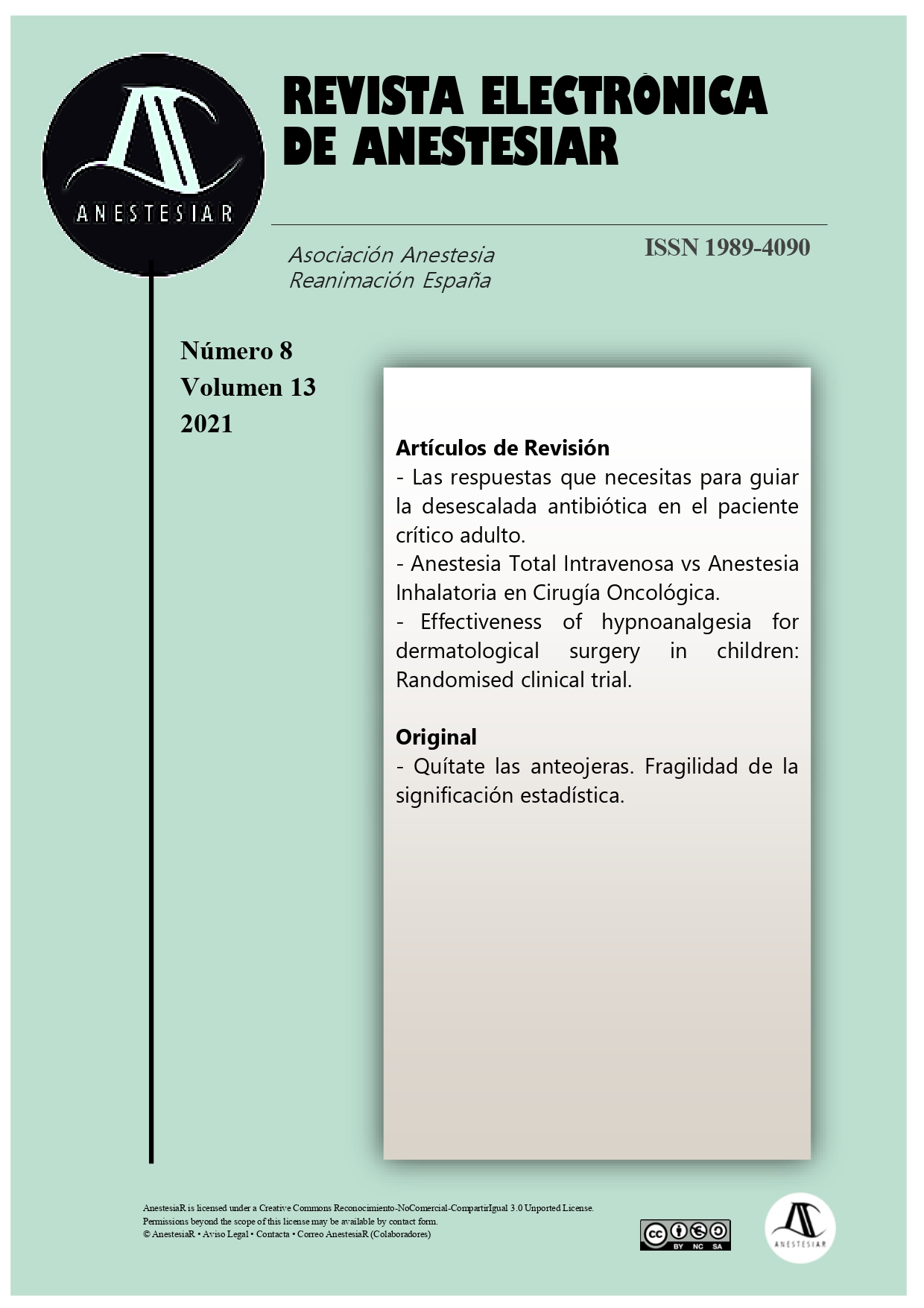Effectiveness of hypnoanalgesia for dermatological surgery in children: Randomised clinical trial
DOI:
https://doi.org/10.30445/rear.v13i8.949Palabras clave:
hypnosis, hypnoanalgesia, anxiety, pain, paediatric surgery, dermatologyResumen
Background and Objective. Diagnostic or therapeutic procedures may generate pain, fear or anxiety. The aim of this paper is to assess whether hypnosedation in children undergoing dermatological surgery is effective in reducing the doses of sedation and analgesia during the periprocedure.
Patients and methods. Clinical trial in which paediatric patients scheduled for removal of benign skin lesions in a hospital were randomised to receive hypnosis (intervention group) or attention-distracting techniques (control group). The outcome measures used were doses of sedation (propofol) during surgery, and the need for analgesia (paracetamol and others) and pain assessment by visual analogue scale (VAS), post-surgery and at 24 hours.
Results. Thirty patients between 5 and 16 years of age were selected consecutively, two of them being excluded because they did not meet the criteria; 15 patients were assigned to the hypnosis group and 13 to the control. Patients treated with hypnosis as an adjuvant to conscious sedation showed a lower need for propofol (median 1.8 mg/Kg; P25-75 1.6 - 2.0) than those treated with distraction (2.9; 2.5 - 3.0; p=0.001). Eighty percent of the children in the hypnosis group needed post-surgical paracetamol versus 100% in the control (p=0.226); after 24 h after discharge the difference in need of ibuprofen was 6.7% versus 38.5% (p=0.041) and of analgesics in general 46.7% versus 84.6% (p=0.082). The VAS of pain during the procedure in the hypnosis group was VAS 0 (0-0) vs 0 (0-5.5) (p=0.142).
Conclusions. Hypnosis as an adjuvant to sedation in children undergoing major outpatient surgery
Citas
Faymonville ME, Mambourg PH, Joris J, Vrijens B, Fissette J, Albert A, et al. Psychological approaches during conscious sedation. Hypnosis versus stress reducing strategies: a prospective randomized study. Pain. 1997;73:361-7.
https://doi.org/10.1016/s0304-3959(97)00122-x
Duparc-Alegria N, Tiberghien K, Abdoul H, Dahmani S, Alberti C, Thiollier AF. Assessment of a short hypnosis in a paediatric operating room in reducing postoperative pain and anxiety: A randomised study. J Clin Nurs. 2018;27:86-91.
https://doi.org/10.1111/jocn.13848
Fortier MA, Weinberg M, Vitulano LA, Chorney JM, Martin SR, Kain ZN. Effects of therapeutic suggestion in children undergoing general anesthesia: a randomized controlled trial. Paediatr Anaesth. 2010;20:90-9.
https://doi.org/10.1111/j.1460-9592.2009.03225.x
Miller K, Tan X, Hobson AD, Khan A, Ziviani J, O'Brien E, et al. A Prospective Randomized Controlled Trial of Nonpharmacological Pain Management During Intravenous Cannulation in a Pediatric Emergency Department. Pediatr Emerg Care. 2016;32:444-51.
https://doi.org/10.1097/PEC.0000000000000778
Lohkamp LN, Mottolese C, Szathmari A, Huguet L, Beuriat PA, Christofori I, et al. Awake brain surgery in children-review of the literature and state-of-the-art. Childs Nerv Syst. 2019;35:2071-7.
https://doi.org/10.1007/s00381-019-04279-w
Browne PD, den Hollander B, Speksnijder EM, van Wering HM, Tjon ATW, George EK, et al. Gut-directed hypnotherapy versus standard medical treatment for nausea in children with functional nausea or functional dyspepsia: protocol of a multicentre randomised trial. BMJ Open. 2019;9:e024903.
https://doi.org/10.1136/bmjopen-2018-024903
Calipel S, Lucas-Polomeni MM, Wodey E, Ecoffey C. Premedication in children: hypnosis versus midazolam. Paediatr Anaesth. 2005;15:275-81.
https://doi.org/10.1111/j.1460-9592.2004.01514.x
Lynn SJ, Kirsch I, Barabasz A, Cardena E, Patterson D. Hypnosis as an empirically supported clinical intervention: the state of the evidence and a look to the future. Int J Clin Exp Hypn. 2000;48:239-59.
https://doi.org/10.1080/00207140008410050
Pelaez-Perez JM. Entrée dans l'IRM. Le tunnel magique et filin. Revue Hypnose & Thérapies brèves. 2019:50-2.
Kuttner L. Pediatric hypnosis: pre-, peri-, and post-anesthesia. Paediatr Anaesth. 2012;22:573-7.
https://doi.org/10.1111/j.1460-9592.2012.03860.x
Mackey EF. An Extension Study Using Hypnotic Suggestion as an Adjunct to Intravenous Sedation. Am J Clin Hypn. 2018;60:378-85.
https://doi.org/10.1080/00029157.2017.1416279
Oleness K, Kohen DP. Hypnosis and Hypnotherapy with children. 4th ed. New York: Guillford; 1996.
Richardson J, Smith JE, McCall G, Pilkington K. Hypnosis for procedure-related pain and distress in pediatric cancer patients: a systematic review of effectiveness and methodology related to hypnosis interventions. J Pain Symptom Manage. 2006;31:70-84.
https://doi.org/10.1016/j.jpainsymman.2005.06.010
Wood C, Bioy A. Hypnosis and pain in children. J Pain Symptom Manage. 2008;35:437-46.
https://doi.org/10.1016/j.jpainsymman.2007.05.009
Faymonville ME, Laureys S, Degueldre C, DelFiore G, Luxen A, Franck G, et al. Neural mechanisms of antinociceptive effects of hypnosis. Anesthesiology. 2000;92:1257-67.
https://doi.org/10.1097/00000542-200005000-00013
Tosti G. Definitions et rouages de l’hypnosis. In: Eyrolles G, editor. Le grand livre de l’hypnose. Paris2016. p. 38-40.
Vanhaudenhuyse A, Boly M, Balteau E, Schnakers C, Moonen G, Luxen A, et al. Pain and non-pain processing during hypnosis: a thulium-YAG event-related fMRI study. Neuroimage. 2009;47:1047-54.
https://doi.org/10.1016/j.neuroimage.2009.05.031
Raja SN, Carr DB, Cohen M, Finnerup NB, Flor H, Gibson S, et al. The revised International Association for the Study of Pain definition of pain: concepts, challenges, and compromises. Pain. 2020.
https://doi.org/10.1097/j.pain.0000000000001939
Montgomery GH, DuHamel KN, Redd WH. A meta-analysis of hypnotically induced analgesia: how effective is hypnosis? Int J Clin Exp Hypn. 2000;48:138-53.
https://doi.org/10.1080/00207140008410045
Montgomery GH, Schnur JB, Kravits K. Hypnosis for cancer care: over 200 years young. CA Cancer J Clin. 2013;63:31-44.
https://doi.org/10.3322/caac.21165
Manyande A, Cyna AM, Yip P, Chooi C, Middleton P. Non-pharmacological interventions for assisting the induction of anaesthesia in children. Cochrane Database Syst Rev. 2015:Cd006447.
https://doi.org/10.1002/14651858.CD006447.pub3
Friedrichsdorf SJ. Multimodal pediatric pain management (part 2). Pain Manag. 2017;7:161-6.
https://doi.org/10.2217/pmt-2016-0051
Thompson T, Terhune DB, Oram C, Sharangparni J, Rouf R, Solmi M, et al. The effectiveness of hypnosis for pain relief: A systematic review and meta-analysis of 85 controlled experimental trials. Neurosci Biobehav Rev. 2019;99:298-310.
Descargas
Publicado
Cómo citar
Número
Sección
Licencia
Derechos de autor 2021 Revista Electrónica AnestesiaR

Esta obra está bajo una licencia internacional Creative Commons Atribución-CompartirIgual 4.0.
 Envío y derechos de autor
Envío y derechos de autor


 Revista Electrónica AnestesiaR by
Revista Electrónica AnestesiaR by 